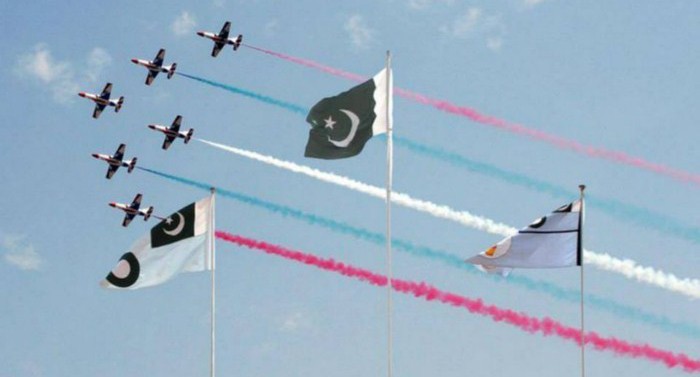
When in a country symbols of hatred outnumber the symbols of bonding, know there is something wrong. And we are at that precise point

The recent resumption of 23rd March parade by the armed forces is being celebrated as a triumph. Is it really a triumph, a mere and meek statement of triumph, or an attempt at a symbolic gesture that denotes power, and implies triumph?
Symbols are like gestures. Gestures hold the key in human communication for they transcend the boundaries of language while symbols hold the key in collective reiterations. Gestures are personal, intimate and embedded in our physical being; symbols tend to be impersonal and disembodied. Gestures are social entities; symbols are political. The former serve humans in quick communication, the latter serve institutions, and the powers associated with those institutions in instant assertions.
There are many gestures which when interface with symbols denote collective statements. Consider burning of a flag by angry mob; children looking for food in garbage; or two lovebirds holding hands.
When a junior colleague in our bureaucracy visits a senior’s office, he waits for his senior’s gesture to be seated. But wearing a certain religious look that denotes the wearer’s association with a certain sub-faith is a symbol. Gestures are quiet codes of silent conversation. Symbols are silent codes of loud expressions.
Symbols, gestures and languages have grown along with our social organisation and power equations. While gestures and language have a closer and more organic link with the social geography of people, symbols have spread along with the invasions by armies or arrival of the missionaries.
Thus a symbol may not be as native, or a native at all, as a gesture is. However, in the collusion of power and politics, both symbols and gestures seem to be taking the side of the powerful.
In Pakistan, as part of state’s political project, we have deliberately invested more in selected symbols. These symbols relate to our identity, our assumed power, our potential triumph, our counter-fear and political statements of patriotism. There is nothing wrong with that. The institutions responsible for generating collective messages on behalf of a country and its inhabitants do that all over the world. In other countries, alongside symbols of power, there are symbols of prosperity and celebration.
When, in a country, symbols of hatred outnumber the symbols of bonding, know there is something wrong. And we are that precise point.
After the end of Mughal rule in India in 1857, which many of us like to recall as Muslim rule, our political elite started using and investing in symbols which could potentially reinforce our distinct Muslim identity. It must appear different from our intrinsic Indian and multiple identities. This movement can be described as a drive of large scale and layered denials, where in popular imagination they made us move away from India and closer to the Middle East.
In America, Australia and Canada, the migrants from old England took with them the names of streets and cities. In Pakistan, we equated the partition with the forced migration of millions with the holy migration of the Prophet (PBUH) from Mecca to Madina and, quite like the latter one, many of us still believe that one day we will go back and take over Delhi’s Laal Qilla, the symbol of lost Muslim power and glory.
During the Zia era, this renaming and conquering of our own former self began in earnest. The culmination of that drive was the decision to plant date palms in Lahore or Islamabad by some bureaucrats. They didn’t realise perhaps that it was like throwing a desert over an orchard. But then symbols must hold sway.
The parade was great: it looked great, and we have been repeatedly told that it also felt great. If for some reason, you are not the one who did not feel great, there is something wrong with you. Or maybe at least one symbol has become irrelevant!
The powerful invest in symbols because these are gestures that tend to establish an instant writ. But, in the face of fast depleting writ of the state, how effective a symbolic reiteration of intended writ can be needs some deeper thinking and candid contemplation.
Once I was driving past Islamabad’s F-9 park with my mother. In the crossing on Jinnah Avenue, they had installed the replica of a missile. My mother asked, "Why have they put here such a big ice lolly (qulfi)?"
I reckon symbols are important or intimidating only for those who know the language of power and its associated symbolic discourse. For many millions in the country, the parade is only an ice lolly festival.